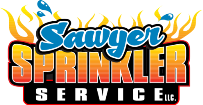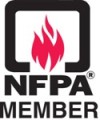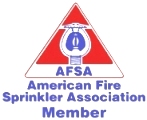Let's go over the systems and the different environmental conditions they address.
Wet sprinkler systems are the most common type used today. They consist of piping filled with water and closed sprinkler heads installed throughout the protected area. Heat from a fire will burst the core of the sprinkler head allowing water to flow from that head only. As the fire spreads, heat will burst additional cores and activate additional heads.
Dry Pipe Sprinkler Systems are commonly used in environments that are prone to freezing. Water is active to the bottom of the Dry Valve and compressed air fills the protected area’s piping above the valve. When a closed head’s core burst, air pressure is released to a point that activates the dry valve and allows water to flood the system piping. Water will only exit the head with burst core. As the fire spreads, heat will burst additional cores and activate additional heads.
Preaction Sprinkler Systems are commonly used in environments that can damage equipment/electronics. Water is active to the bottom of the Preaction Valve and compressed air is sometimes used in the protected area’s piping above the valve. The preaction valve will let water flow into the piping after a detection system activates a releasing solenoid. These systems are commonly activated through smoke detectors, heat detectors, loss of pressure in system piping or a combination of 2 or more conditions.
Deluge Sprinkler Systems are commonly used in Flammable liquid handling/storage areas, Petroleum/Chemical Plants, and Aircraft Hangers. Water is active to the bottom of the Deluge Valve and the protected area’s piping often have open sprinkler heads. The deluge valve will let water flow into the piping after a detection system activates a releasing solenoid. These systems are commonly activated through smoke detectors, heat detectors, loss of pressure in system line detection piping. When the system is equipped with open heads, all heads will flow when the valve is operated.
Antifreeze Loops protect areas in a building that are apt to freeze. A check valve isolates the antifreeze loop from the sprinkler system. There is also a main drain and a fill cup for draining and refilling of the loop. Antifreeze loops can be filled with different liquids, the most common are: propylene glycol, glycerin and ethylene glycol. If the sprinkler system is connected to the public water supply, ethylene glycol should not be used because it is considered poisonous. Systems that are installed with CPVC plastic piping can only be filled with glycerin type antifreeze. A listed expansion chamber of appropriate size and charged air pressure needs to be provided to compensate for thermal expansion of the antifreeze on most systems.
Foam Sprinkler Systems suppress fire by separating the fuel from the air that allows it to burn. Depending on the foam system, it is done in several ways:
• Foam creates a blanket on the fuel surface, smothering the fire
• The fuel is cooled by the water and foam content
• The blanket of foam suppresses the release of flammable vapors that can ignite



 Wet Sprinkler Systems by Sawyer Sprinkler Service
Wet Sprinkler Systems by Sawyer Sprinkler Service